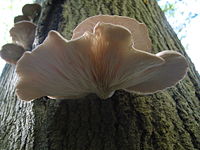
Photo from wikipedia
Dark septate endophytes (DSEs) are the typical representatives of root endophytic fungi in heavy metal (HM)-contaminated environments. However, little is known about their roles in the HMs tolerance of hosts… Click to show full abstract
Dark septate endophytes (DSEs) are the typical representatives of root endophytic fungi in heavy metal (HM)-contaminated environments. However, little is known about their roles in the HMs tolerance of hosts and the underlying mechanism. Here, we investigated the biological roles and molecular mechanisms of a DSE strain Falciphora oryzae in alleviating cadmium (Cd) toxicities in rice. It was found that F. oryzae possessed a capacity of accumulating Cd in its vacuoles and chlamydospores. During symbiosis, F. oryzae conferred improved Cd tolerance to rice, decreasing Cd accumulation in roots and translocation to shoots. F. oryzae alleviated Cd toxicity to rice by sequestering Cd in its vacuoles. Further application of F. oryzae as fertilizer in the field could reduce Cd content in rice grains. We identified a SNARE Syntaxin 1 gene through proteomics, which participated in Cd tolerance of F. oryzae by regulating chlamydospore formation and vacuole enlargement. This study provided novel insights into how the DSEs and their host plants combat Cd stress.
Journal Title: Journal of hazardous materials
Year Published: 2021
Link to full text (if available)
Share on Social Media: Sign Up to like & get
recommendations!